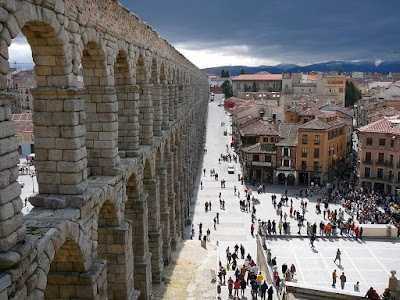By Amy Barr of The Lukeion Project
 |
| Segovia, Spain |
Carthage straddled the midpoint of the Mediterranean and, as the world’s first big-box-store, she became staggeringly wealthy and self-important. The rather earthy Romans took offense at her hubris, her bedazzled purple fashions, and her insistence on taking over all the islands closest to Rome’s expansion zones. Stubborn to a fault, the Romans taught themselves how to build and sail the battleships she needed to combat Carthaginian claims on Sicily, Corsica, and Sardinia. As was often the case for young Rome, she won the first Punic (Phoenician) War mainly because she refused to quit and, secondarily, because she figured out how to use land battle techniques against a bunch of sailors.
Carthage took her toys and went home, at least for a little while. Undaunted, she soldiered through post-war financial setbacks by sleuthing out juicy new trade opportunities. Spain, it turned out, was jam-packed with gold, silver, and timber. The Phoenicians knew a good deal when they saw it and moved in.
While the two old enemies continued to glower at each other for quite a while, cheeky Hannibal fanned the flames when he terrorized Saguntum, one of Rome’s protectorates in Spain. Hannibal surprisingly saddled up an assortment of confused elephants and doubled down: Nobody expected elephants nor sun-loving Carthaginians to stream into Italy from the north. Things went badly for a long time (Hannibal was tricksy).
While Hannibal Barca, the apparent brains of the operation, was busy bamboozling Romans in Italy, Scipio, a sort of Roman Chuck Norris, winningly attacked Hannibal’s less capable relatives in Spain in 206 BC. No more Spanish groceries for Hannibal meant Rome would astonishingly mark another win, mainly because she refused to quit.
In less than a decade, the Romans had her new prize, Spain, split in two. Creatively, she named the two provinces Spain-Over-Here (Hispania Citerior) and Spain-Over-There (Hispania Ulterior).
Eventually, Rome took Spain over everywhere as she put down rebellion after spicy rebellion.
In 61 BC, Julius Caesar as a praetor (governor) in Hispania Citerior used ersatz Spanish-rebellion-squashing as an excellent way to pay off his massive political debts.
Augustus formalized Rome’s new ownership of the peninsula by adding a third regional distinction, Hispania Tarraconensis (modern Tarragona). As Rome settled in, she established her signature infrastructure.
What did the Romans ever do for Spain? Soon everyone enjoyed excellent roads (900-mile superhighway), fresh water (massive aqueducts dotted the land), and top-notch entertainment in nice new theaters. Veterans, promised a plot of land upon retirement, started choosing sunny Spain as Romans founded Augusta Emerita (Merida), Asturica Augusta (Astorga), Colonia Caesar Augusta or Caesaraugusta (Zaragoza), and Lucus Augusti (Lugo). Two of Rome’s best emperors, Trajan and Hadrian, came from Spain. Let's not forget Rome's contribution to Spain's languages: Spanish, Portuguese, Galician, Mirandese, Asturian, Leonese, Aragonese, Ladino, Catalan/Valencian, Occitan, and Gascon -- all maintain a link to the Latin language.
You Must Visit
Founders of The Lukeion Project have been leading annual tours to Italy, Greece, and Turkey since 2008. While it is impossible to grow bored with these destinations, as Classical Archaeologists we are more aware than most that the Greeks and Romans left their deep and lasting imprint throughout the Mediterranean, not just a few popular regions. Contrary to Wikipedia, Spain’s rich history begins long before the Middle Ages. We invite you to join us in our first tour of Spain. Expect a very busy two weeks, May 18-31, 2020. Here and here are the details. The bus (our own private bus, mind you) is already half full. Register now.Here are the highlights:
- Barcelona
- Las Ramblas
- Gaudí’s Sagrada Familia visit
- Barcelona City History Museum
- Tarragona
- Pont de les Ferreres Aqueduct
- Archaeological Museum Visit
- Roman Ruins & Theater
- Castle visit
- Sagunt (Saguntum – the city that prompted the second Punic War)
- Valencia
- Cartagena
- Nova Cartago, founded by Phoenicians
- Muses del Teatro Romono
- Muralla Byzantina
- Granada
- Royal Chapel
- Alhambra
- Ronda
- Puente Nuevo
- Seville -- the birthplace of emperors Trajan and Hadrian
- Bullring visit (not a bullfight)
- Amphitheater
- Mosaics (Casa de los Pajaros and others)
- Italica
- Merida
- Roman Ruins
- Museo Nacional de Arte Romano
- Toledo
- Madrid
- Royal Palace
- Prado
- National Archaeological Museum
- Segovia
- Historic Castle
- Roman Aqueduct




No comments:
Post a Comment